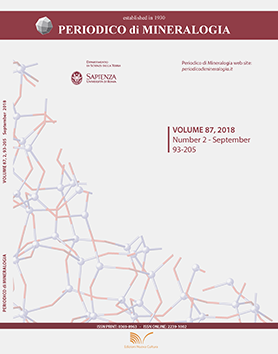Thermally induced behavior of the K-exchanged erionite: a further step in understanding the structural modifications of the erionite group upon heating
DOI:
https://doi.org/10.2451/2018PM769Keywords:
K-exchanged erionite, TG/DSC analyses, in situ X-ray powder diffraction, Rietveld method, thermal behaviourAbstract
Fibrous erionite is a naturally occurring zeolite considered to be highly carcinogenic upon inhalation, even more than crocidolite. Since no iron is typically present in erionite, its toxicity has been attributed to ion-exchanged Fe participating in Fenton chemistry. Recently, a study aimed at investigating possible fiber inactivation routes surprisingly showed that, despite having completely occluded all available pores with K ions, the erionite-Na sample preserved the property to upload Fe (II) within the structure. In this work, the thermal behavior of the K-exchanged erionite-Na was investigated by TG/DSC and in situ XRPD analyses in order to provide relevant information for modeling the thermally induced behavior of the erionite group. Rietveld refinement results evidenced a general trend of cell parameters and volume with temperature similar to that observed for erionite-K from Rome (Oregon, USA). However, the dependenceof Tdehydr and Tbreak from Si/Si+Al ratio observed in zeolites (high Si content favoursa lower Tdehydr and a higher Tbreak) is not observed, possibly due to the effect of the relevant amount of large K ions dispersed within the erionite cage, acting as reinforcing blocks for the framework. Heating produces a progressive emptying of the Ca sites, common effect previously observed in erionite samples showing different chemistry. In addition, K1 s.s. remains unchanged evidencing the absence of any “internal ion exchange” process, whereas s.s. at K2 increases in the range 438-573 K and then slowly decreases in the range 700-1218 K. Both Rietveld and DSC data suggest the motion of K ions from OW sites toward the walls of the erionite cavity during dehydration.


